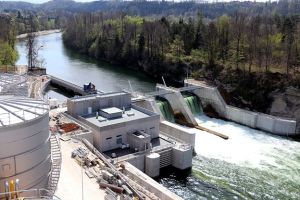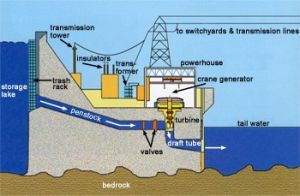Federal Energy Regulatory Commission: Difference between revisions
No edit summary |
No edit summary |
||
| Line 1: | Line 1: | ||
<!-- Default code to remove table of contents and add line break at top of page --> | |||
__NOTOC__ | |||
<!-- Add Category to drive breadcrumb menus --> | |||
[[Category:Agencies]] | [[Category:Agencies]] | ||
---- | ---- | ||
The Federal Energy Regulatory Commission (FERC) is the | |||
[[File: FERC Logo.png | right | 150px | frameless | link=https://www.ferc.gov/]]</br> | |||
<!-- | |||
{{Picture | |||
|image= FERC Logo.png | |||
|link=https://www.ferc.gov/ | |||
|caption= | |||
}} | |||
--> | |||
<!-- Introductory paragraph or topic page summary --> | |||
The Federal Energy Regulatory Commission (FERC) is an independent regulatory Federal agency under the Department of Energy with the responsibility to regulate national energy resources across the nation. It regulates natural gas and oil pipelines and the transmission of electrical power. It also regulates the production of non-federal hydroelectric power. FERC regulates the safety of about 1,600 hydroelectric projects (with a total of over 2,500 dams) are regulated by FERC. Dam safety is regulated within FERC by the Division of Dam Safety and [[Inspections]]. It has five regions: | |||
{| align="center" style="width:10%;" cellpadding="7" | |||
| [[Image:FERC Regions and Regional Office Locations.jpg]] | |||
|- | |||
|style="text-align:center; font-size:75%;"| FERC Regions and Regional Office Locations | |||
|} | |||
== Purpose of FERC == | |||
FERC Regulates the hydropower dams owned by: companies, private individuals, municipalities, and states. | |||
FERC Does not regulate the hydropower dams owned by Federal Agencies such as the USACE, Reclamation, and TVA. However, FERC does have regulatory authority over non-federal hydropower additions/modifications to federal dams (e.g. adding hydropower to a USACE dam). | |||
{| align="center" style="width:10%;" cellpadding="7" | |||
| [[image: Hydropower Dam and Plant.jpg | link= | frameless]] | |||
| [[image: Hydropower Diagram USBR.jpg | link= | frameless]] | |||
|- | |||
| style="text-align:center; font size:75%;" | Hydropower Dam and Plant | |||
| style="text-align:center; font size:75%;" | Hydropower Diagram (Source: USBR) | |||
|} | |||
The primary authority for regulating new projects or the [[operation]] of existing hydropower projects is the FERC license. The licenses are renewable with terms of 30-50 years. There are three hazard potential classifications that FERC uses: High, Significant, and Low. FERC requires Independent Consultants (ICs) to review the safety of High and Significant hazard potential projects. Periodic Inspections (PIs) and Comprehensive Assessments (CAs) alternate every 5 years. A requirement to perform Potential Failure Mode Analysis (PFMA) was added in the early 2000’s. In 2022, FERC also added a requirement that licensees perform Level 2 Semi-Quantitative Risk Analyses (L2RA) during the CA using an Independent Consultant team. | |||
FERC Requires licensees to have a Chief Dam Safety Officer or Chief Dam Safety Coordinator. Licensees with high hazard dams are also required to have documented [[Owner]] [[Dam Safety Programs]] (ODSPs). | |||
== Resources == | |||
FERC has an extensive web presence. Here are online resources regarding the dam safety aspects of hydropower: | |||
{{Website Icon}} [https://www.ferc.gov/industries-data/hydropower FERC Hydropower Home Page] | |||
{{Website Icon}} [https://www.ecfr.gov/current/title-18/chapter-I/subchapter-B/part-12#12.10 CFR Title 18, Part 12 Regulations] | |||
{{Website Icon}} [https://www.ferc.gov/dam-safety-and-inspections Division of Dam Safety and Inspections (D2SI) - The FERC division that is responsible for dam safety] | |||
{{Website Icon}} [https://www.ferc.gov/dam-safety-and-inspections/regional-engineer-contacts DSI Regional Engineers contact information] | |||
{{Website Icon}} [https://www.ferc.gov/industries-data/hydropower/dam-safety-and-inspections/eng-guidelines FERC Engineering Guidelines for the Evaluation of Hydropower Projects] | |||
<!-- Citations will automatically populate if instructions on the "[[Guidelines for Inserting a Citation]]" are followed. --> | |||
<!-- {{Citations}} --> | |||
<!-- Revision history information --> | |||
{{revhistinf}} | |||
Revision as of 22:00, 1 August 2023

The Federal Energy Regulatory Commission (FERC) is an independent regulatory Federal agency under the Department of Energy with the responsibility to regulate national energy resources across the nation. It regulates natural gas and oil pipelines and the transmission of electrical power. It also regulates the production of non-federal hydroelectric power. FERC regulates the safety of about 1,600 hydroelectric projects (with a total of over 2,500 dams) are regulated by FERC. Dam safety is regulated within FERC by the Division of Dam Safety and Inspections. It has five regions:

|
| FERC Regions and Regional Office Locations |
Purpose of FERC
FERC Regulates the hydropower dams owned by: companies, private individuals, municipalities, and states.
FERC Does not regulate the hydropower dams owned by Federal Agencies such as the USACE, Reclamation, and TVA. However, FERC does have regulatory authority over non-federal hydropower additions/modifications to federal dams (e.g. adding hydropower to a USACE dam).

|

|
| Hydropower Dam and Plant | Hydropower Diagram (Source: USBR) |
The primary authority for regulating new projects or the operation of existing hydropower projects is the FERC license. The licenses are renewable with terms of 30-50 years. There are three hazard potential classifications that FERC uses: High, Significant, and Low. FERC requires Independent Consultants (ICs) to review the safety of High and Significant hazard potential projects. Periodic Inspections (PIs) and Comprehensive Assessments (CAs) alternate every 5 years. A requirement to perform Potential Failure Mode Analysis (PFMA) was added in the early 2000’s. In 2022, FERC also added a requirement that licensees perform Level 2 Semi-Quantitative Risk Analyses (L2RA) during the CA using an Independent Consultant team.
FERC Requires licensees to have a Chief Dam Safety Officer or Chief Dam Safety Coordinator. Licensees with high hazard dams are also required to have documented Owner Dam Safety Programs (ODSPs).
Resources
FERC has an extensive web presence. Here are online resources regarding the dam safety aspects of hydropower:
![]() CFR Title 18, Part 12 Regulations
CFR Title 18, Part 12 Regulations
![]() Division of Dam Safety and Inspections (D2SI) - The FERC division that is responsible for dam safety
Division of Dam Safety and Inspections (D2SI) - The FERC division that is responsible for dam safety
![]() DSI Regional Engineers contact information
DSI Regional Engineers contact information
![]() FERC Engineering Guidelines for the Evaluation of Hydropower Projects
FERC Engineering Guidelines for the Evaluation of Hydropower Projects
Revision ID: 7546
Revision Date: 08/01/2023
